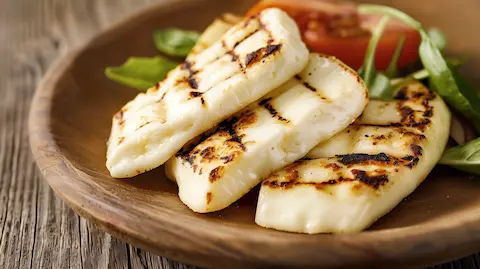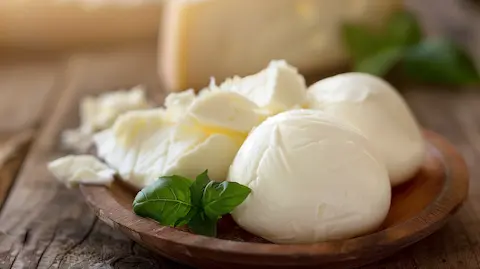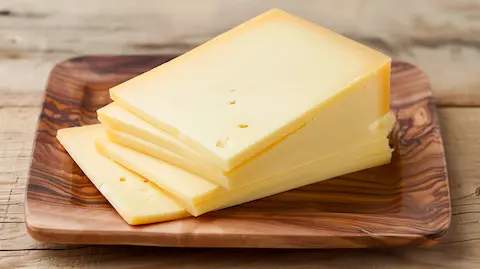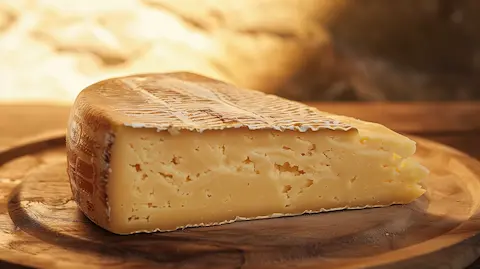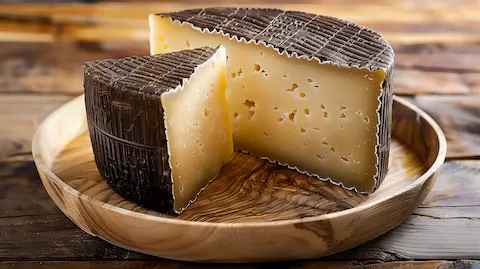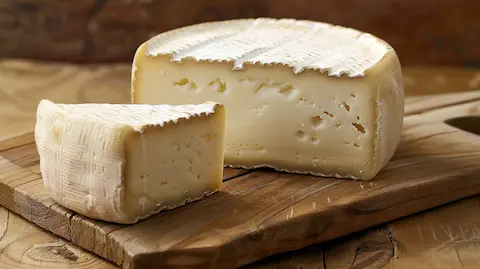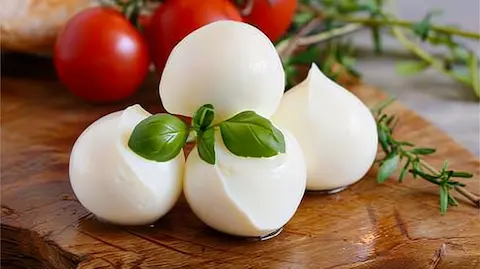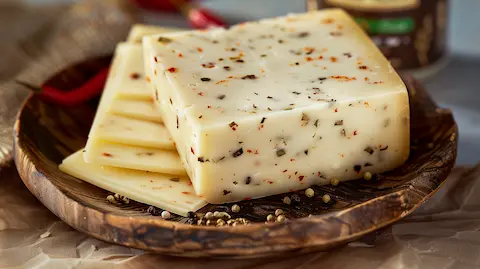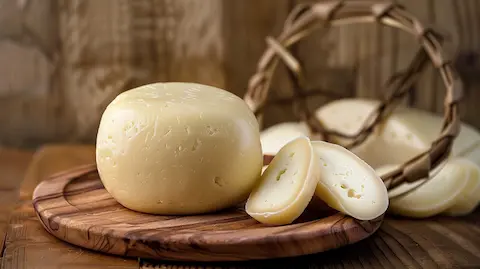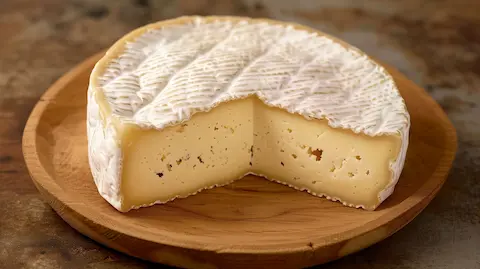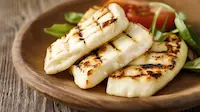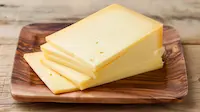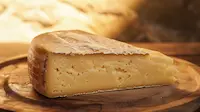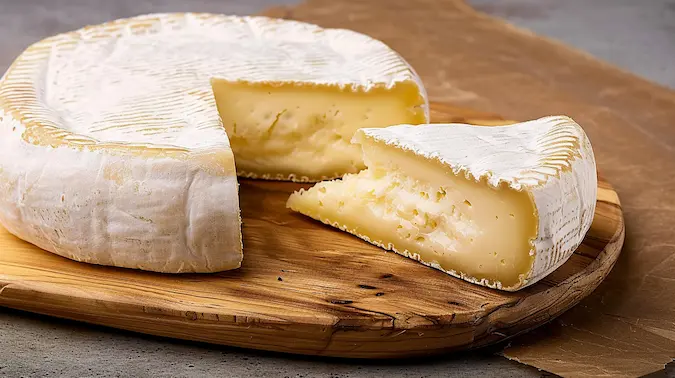Reblochon Cheese
Reblochon is a soft, washed-rind cheese with a fine velvety rind and a creamy, buttery center. Originating from the alpine regions of Savoie in France, this cheese is a product of rich tradition, crafted since the 13th century. Reblochon's name itself hints at its history, derived from the French word 'reblocher', which means 'to pinch a cow's udder again'. This refers to the practice of holding back some of the milk from the first milking to avoid full tax payment, and then milking the cow a second time to produce a richer milk, from which Reblochon is made.
Characterized by its nutty taste and a slight hint of fruitiness, Reblochon has a supple and smooth texture that melts in the mouth. It is traditionally made from the raw milk of Abondance, Montbéliarde, and Tarine cows that graze on the floral alpine pastures. The cheese is aged in cool mountain caves where it develops its unique flavor and aroma. Reblochon is a cheese of celebration, often enjoyed in regional dishes like tartiflette, and savored with a glass of crisp white wine.
How is Reblochon Made?
Reblochon cheese is made from the raw milk of Abondance, Montbéliarde, and Tarine cows. The process begins with the evening milking, which is left to stand overnight, allowing the cream to rise to the top. The next morning, the milk is partially skimmed before being gently heated. Rennet is added to coagulate the milk, forming curds which are then cut into walnut-sized pieces to encourage whey separation. The curds are placed into molds and pressed lightly to retain moisture and achieve the desired texture. Each cheese is salted and then transferred to cellars to age for at least two weeks. During this time, the cheese is regularly turned and washed with whey to develop its distinctive rind and flavor profile.
Reblochon Cheese Production Process
| Step | Description | Ingredients | Temperature | Duration |
|---|---|---|---|---|
| 1. Skimming | Evening milk is left to stand overnight; cream rises to the top. | Raw cow's milk | Room temperature | 12 hours |
| 2. Heating | Partially skimmed milk is gently heated. | Skimmed raw milk | 27-33°C (80-91°F) | Variable |
| 3. Coagulation | Rennet is added to form curds. | Rennet | 27-33°C (80-91°F) | 30-40 minutes |
| 4. Cutting | Curds are cut into walnut-sized pieces to separate whey. | Variable | ||
| 5. Molding and Pressing | Curds are placed into molds and lightly pressed. | 18-24 hours | ||
| 6. Salting | Each cheese is salted before aging. | Salt | Variable | |
| 7. Aging | Cheese is aged in cellars; turned and washed with whey. | Whey | 13°C (55°F) | Minimum 2 weeks |
What does Reblochon taste like?
Reblochon tastes like a harmonious blend of nutty flavors with a whisper of fruitiness, complemented by a creamy, buttery texture. Its rich and unctuous center delivers a melt-in-the-mouth experience, while the washed rind imparts a subtle earthiness that adds depth to the overall flavor profile. This cheese is a true reflection of the alpine pastures, offering a taste that is both rustic and refined.
Reblochon Cheese Profile
Exploring the characteristics of Reblochon reveals the depth of its heritage and the meticulous care in its creation. Below is a profile that encapsulates the defining attributes of this cherished cheese:
- Made from: Raw cow's milk
- Country of origin: France
- Region: Savoie, Haute-Savoie
- Family: Washed-rind
- Type: Soft
- Texture: Creamy and supple
- Rind: Washed, velvety
- Colour: Pale yellow
- Flavour: Nutty with a hint of fruitiness
- Aroma: Mild and earthy
- Vegetarian: No, due to traditional animal rennet
- Producers: Small-scale farms and artisanal cheesemakers
- Safe for dogs: Not recommended due to lactose content and rich fat
- PDO status: Protected Designation of Origin since 1958
How to Store Reblochon?
Proper storage of reblochon is key to preserving its delicate flavor and creamy texture. In the fridge, wrap Reblochon in wax or parchment paper, which allows the cheese to breathe and maintain optimal humidity. Then, place it inside a loose-fitting food-grade plastic bag or a cheese container to protect it from absorbing other flavors and to prevent it from drying out.
- Initial Wrapping: Wrap Reblochon in wax or parchment paper.
- Secondary Protection: Place the wrapped cheese in a loose-fitting plastic bag or cheese container.
- Refrigeration: Store in the vegetable compartment of the refrigerator, where the temperature is consistent but not too cold.
- Monitoring: Check the cheese regularly for any signs of spoilage or mold and consume within the recommended time frame.
How long does Reblochon cheese last?
Reblochon cheese has a delicate balance of flavor and texture that can be maintained with proper storage. In the fridge, it can last for up to three weeks. Freezing Reblochon is not advisable as it can significantly alter the cheese's texture, making it crumbly, and can dampen its rich flavor once thawed.
| Storage Location | Shelf Life | Texture After Thawing | Taste After Thawing |
|---|---|---|---|
| Outside | 2 hours | ||
| Fridge | Up to 3 weeks | ||
| Freezer | Not recommended | Crumbly | Dampened flavor |
Can You Freeze Reblochon?
No, freezing Reblochon is not recommended. While it's technically possible to freeze this cheese, doing so can change the texture and moisture content, leading to a crumbly texture and a less creamy mouthfeel upon thawing. The subtle flavors that make Reblochon distinctive could also be muted. To enjoy Reblochon at its best, store it in the refrigerator as described above.
Alternatives to Reblochon Cheese
If you're seeking a cheese that mirrors the creamy and sumptuous nature of Reblochon but with a twist, or if Reblochon is unavailable, there are several excellent alternatives to consider. These substitutes offer similar textures and flavor profiles, making them suitable for your culinary needs. The following table provides a detailed look at each alternative and explains why they might be a good fit for your next cheese adventure.
Reblochon Cheese Substitutes
| Cheese | Origin | Milk Source | Texture | Flavor | Aging Time | Best Used In |
|---|---|---|---|---|---|---|
| Taleggio | Italy | Cow | Soft | Fruity, meaty | 6-10 weeks | Risotto, polenta, on bread |
| Brie | France | Cow | Soft | Buttery, earthy | 4-5 weeks | With fruit, on crackers, baked |
| Fontina | Italy | Cow | Semi-soft | Nutty, mild | 3 months | Fondue, gratins, pizza |
| Camembert | France | Cow | Soft | Rich, buttery | 3-5 weeks | With bread, meats, baked |
| Munster | France/Germany | Cow | Soft | Strong, tangy | 5-7 weeks | With potatoes, quiche, on bread |
| Saint-Nectaire | France | Cow | Semi-soft | Fruity, nutty | 6-8 weeks | Salads, on crackers, melted |
Each of these cheeses can be enjoyed in a variety of dishes or on their own, providing a delightful experience that pays homage to the essence of Reblochon. Whether melted into a dish or served as part of a cheese platter, these alternatives are sure to please the palate and enrich your cheese repertoire.
How to Use Reblochon
Reblochon's creamy texture and rich flavor make it a versatile addition to many dishes. To incorporate Reblochon into a meal, consider the cheese's softness, which allows for easy spreading on breads and crackers. When slicing Reblochon for cooking or plating, use a sharp knife to cut through the velvety rind and into the creamy paste. This cheese is particularly delightful when melted, as it becomes even more luscious, making it ideal for traditional recipes like tartiflette or for elevating simple dishes such as sandwiches and baked potatoes.
- Melting: Melt into dishes like tartiflette, or over roasted vegetables.
- Spreading: Spread on fresh baguette or crackers for a savory snack.
- Slicing: Cut into thin slices to top salads or to feature on cheese platters.
- Cooking: Incorporate into omelets or quiches for a touch of creaminess.
- Pairing: Enjoy with fruits like apples or pears for a sweet and savory combination.
How to Serve Reblochon Cheese
Reblochon is best served at room temperature to fully appreciate its creamy texture and subtle flavors. Present it as part of a cheese board, accompanied by charcuterie, pickles, and crusty bread for a satisfying appetizer. For a simple yet elegant presentation, serve wedges of Reblochon with a drizzle of honey and a sprinkle of chopped nuts. Wine enthusiasts might pair Reblochon with a light-bodied red or a dry white wine to complement its richness.
Recipes Using Reblochon
Reblochon's sumptuous creaminess and complex flavor profile make it a standout ingredient in various dishes. Its ability to melt into a velvety delight enhances the sensory appeal of recipes, infusing them with a touch of Alpine indulgence.
- Tartiflette: This traditional Savoyard dish is a testament to Reblochon's melting quality, creating a comforting, hearty meal that's perfect for cold evenings.
- Croque Monsieur: Elevate this classic French sandwich with Reblochon for a richer, more decadent version that oozes with creamy goodness.
- Gratin Dauphinois: The cheese's richness is a perfect match for the simplicity of potatoes, transforming the gratin into a dish of indulgent comfort.
- Reblochon and Bacon Quiche: The balance between the creamy cheese and the salty crispness of bacon results in a quiche that's both flavorful and satisfying.
- Baked Camembert-style Reblochon: Enjoy Reblochon in a new way by baking it until the center becomes irresistibly gooey, perfect for dipping your favorite bread or vegetables.
Reblochon Nutrition Data
There are 300 calories in Reblochon cheese per 100g. Reblochon is a source of protein and provides essential nutrients such as calcium. However, its high fat content, particularly saturated fat, should be considered when incorporating it into a balanced diet.
| Nutrient | Amount per 100g | % Daily Value* |
|---|---|---|
| Calories | 300 | - |
| Total Fat | 24g | 37% |
| Saturated Fat | 16g | 80% |
| Cholesterol | 90mg | 30% |
| Sodium | 690mg | 29% |
| Total Carbohydrates | 0.5g | <1% |
| Dietary Fiber | 0g | 0% |
| Sugars | 0.5g | - |
| Protein | 19g | 38% |
| Calcium | 500mg | 50% |
*Percent Daily Values are based on a 2,000 calorie diet. Your daily values may be higher or lower depending on your calorie needs.
What's Next? WhatCheese Insights
If you are an enthusiast eager to experience Reblochon, sourcing this cheese may require a visit to a specialty cheese shop or a well-appointed grocer with a diverse international selection. These establishments are more likely to carry authentic Reblochon, ensuring you get to savor the true taste of the French Alps. For those who prefer the convenience of online shopping, numerous gourmet food websites offer Reblochon, often providing detailed descriptions and serving suggestions to enhance your experience.
If you are interested in pairing Reblochon with wine, look for vineyards that offer cheese tastings alongside their wine selections. Such vineyards often feature Reblochon for its compatibility with a range of wines, particularly those from the same region. Additionally, cheese and wine festivals present a splendid opportunity to explore Reblochon's versatility in pairings, with experts providing insights into selecting the perfect wine to match its creamy and nutty profile.
For those who enjoy the creamy and supple nature of Reblochon, Brie de Meaux, Camembert de Normandie, and Vacherin Mont d'Or offer similar indulgent experiences. These cheeses share the lush, spreadable quality that makes them favorites on any cheese board or melted into a variety of warm dishes.
{ "faq": "Frequently asked questions about Reblochon cheese", "questions": [ { "question": "What dishes are best suited for Reblochon cheese?", "answer": "Reblochon cheese is best suited for traditional dishes like tartiflette, and it also adds a creamy, rich flavor to gratins, quiches, and sandwiches. Its melting quality makes it ideal for recipes that require a luscious, velvety cheese." } , { "question": "Is Reblochon cheese suitable for vegetarians?", "answer": "Traditional Reblochon cheese is not suitable for vegetarians as it is made using animal rennet. However, some cheesemakers may offer vegetarian versions that use non-animal rennet." } , { "question": "What are some tips for pairing wines with Reblochon cheese?", "answer": "Reblochon cheese pairs well with a variety of wines. For white wine, choose a light-bodied and crisp variety like Chardonnay or Roussette. If you prefer red wine, a light-bodied red like Gamay or Pinot Noir complements the creamy texture and nutty flavors of Reblochon." } , { "question": "Can Reblochon cheese be used in a cheese fondue?", "answer": "Yes, Reblochon cheese can be used in a cheese fondue. Its creamy texture and ability to melt smoothly make it an excellent choice for a rich and flavorful fondue experience." } , { "question": "What are the health considerations when consuming Reblochon cheese?", "answer": "Reblochon cheese is high in saturated fat and should be consumed in moderation, especially by individuals monitoring their fat intake. It also contains protein and calcium, which are beneficial nutrients." } ] }
